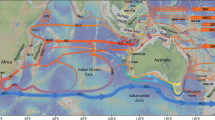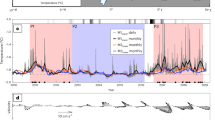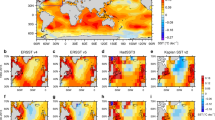Abstract
The Indian monsoon, the largest monsoon system on Earth, responds to remote climatic forcings, including temperature changes in the North Atlantic1,2. The monsoon was weak during two cool periods that punctuated the last deglaciation—Heinrich Stadial 1 and the Younger Dryas. It has been suggested that sea surface cooling in the Indian Ocean was the critical link between these North Atlantic stadials and monsoon failure3; however, based on existing proxy records4 it is unclear whether surface temperatures in the Indian Ocean and Arabian Sea dropped during these intervals. Here we compile new and existing temperature proxy data4,5,6,7 from the Arabian Sea, and find that surface temperatures cooled whereas subsurface temperatures warmed during both Heinrich Stadial 1 and the Younger Dryas. Our analysis of model simulations shows that surface cooling weakens the monsoon winds and leads to destratification of the water column and substantial subsurface warming. We thus conclude that sea surface temperatures in the Indian Ocean are indeed the link between North Atlantic climate and the strength of the Indian monsoon.
This is a preview of subscription content, access via your institution
Access options
Subscribe to this journal
Receive 12 print issues and online access
$259.00 per year
only $21.58 per issue
Buy this article
- Purchase on Springer Link
- Instant access to full article PDF
Prices may be subject to local taxes which are calculated during checkout




Similar content being viewed by others
References
Overpeck, J., Anderson, D., Trumbore, S. & Prell, W. The southwest Indian Monsoon over the last 18,000 years. Clim. Dynam. 12, 213–225 (1996).
Schulz, H., von Rad, U. & Erlenkeuser, H. Correlation between Arabian Sea and Greenland climate oscillations of the past 110,000 years. Nature 393, 54–57 (1998).
Pausata, F. S. R., Battisti, D. S., Nisancioglu, K. H. & Bitz, C. M. Chinese stalagmite δ18O controlled by changes in the Indian monsoon during a simulated Heinrich event. Nature Geosci. 4, 474–480 (2011).
Saraswat, R., Lea, D. W., Nigam, R., Mackensen, A. & Naik, D. K. Deglaciation in the tropical Indian Ocean driven by interplay between the regional monsoon and global teleconnections. Earth Planet. Sci. Lett. 375, 166–175 (2013).
Dahl, K. A. & Oppo, D. W. Sea surface temperature pattern reconstructions in the Arabian Sea. Paleoceanography 21, PA1014 (2006).
Sonzogni, C., Bard, E. & Rostek, F. Tropical sea-surface temperatures during the last glacial period: A view based on alkenones in Indian Ocean sediments. Q. Sci. Rev. 17, 1185–1201 (1998).
Huguet, C., Kim, J.-H., Sinninghe Damsté, J. S. & Schouten, S. Reconstruction of sea surface temperature variations in the Arabian Sea over the last 23 kyr using organic proxies (TEX86 and U37K′). Paleoceanography 21, PA3003 (2006).
McManus, J. F., Francois, R., Gherardi, J.-M., Keigwin, L. D. & Brown-Leger, S. Collapse and rapid resumption of Atlantic meridional circulation linked to deglacial climate changes. Nature 428, 834–837 (2004).
Vellinga, M. & Wood, R. A. Global climatic impacts of a collapse of the Atlantic thermohaline circulation. Climatic Change 54, 251–267 (2002).
Hemming, S. R. Heinrich events: Massive late Pleistocene detritus layers of the North Atlantic and their global climate imprint. Rev. Geophys. 42, RG1005 (2004).
Stager, J. C., Ryves, D. B., Chase, B. M. & Pausata, F. S. R. Catastrophic drought in the Afro-Asian monsoon region during Heinrich event 1. Science 331, 1299–1302 (2011).
Tierney, J. E. & deMenocal, P. B. Abrupt shifts in horn of Africa hydroclimate since the last glacial maximum. Science 342, 843–846 (2013).
Tierney, J. E., Ummenhofer, C. C. & deMenocal, P. B. Past and future rainfall in the Horn of Africa. Sci. Adv. 1, e1500682 (2015).
Liu, Z. et al. Transient simulation of last deglaciation with a new mechanism for Bølling-Allerød warming. Science 325, 310–314 (2009).
Karner, M., DeLong, E. & Karl, D. Archaeal dominance in the mesopelagic zone of the Pacific Ocean. Nature 409, 507–510 (2001).
Schouten, S. et al. Intact polar and core glycerol dibiphytanyl glycerol tetraether lipids in the Arabian Sea oxygen minimum zone: I. Selective preservation and degradation in the water column and consequences for the TEX86 . Geochim. Cosmochim. Acta 98, 228–243 (2012).
Tierney, J. E. & Tingley, M. P. A Bayesian, spatially-varying calibration model for the TEX86 proxy. Geochim. Cosmochim. Acta 127, 83–106 (2014).
Tierney, J. E. & Tingley, M. P. A TEX86 surface sediment database and extended Bayesian calibration. Sci. Data 2, 150029 (2015).
Altabet, M. A., Higginson, M. J. & Murray, D. W. The effect of millennial-scale changes in Arabian Sea denitrification on atmospheric CO2 . Nature 415, 159–162 (2002).
Schulte, S., Rostek, F., Bard, E., Rullkötter, J. & Marchal, O. Variations of oxygen-minimum and primary productivity recorded in sediments of the Arabian Sea. Earth Planet. Sci. Lett. 173, 205–221 (1999).
Caley, T. et al. Southern Hemisphere imprint for Indo-Asian summer monsoons during the last glacial period as revealed by Arabian Sea productivity records. Biogeosci. Discuss. 10, 9315–9343 (2013).
Meehl, G. A. & Arblaster, J. M. Indian monsoon GCM sensitivity experiments testing tropospheric biennial oscillation transition conditions. J. Clim. 15, 923–944 (2002).
Manabe, S. & Stouffer, R. J. Century-scale effects of increased atmospheric CO2 on the ocean–atmosphere system. Nature 364, 215–218 (1993).
Stocker, T. F. & Schmittner, A. Influence of CO2 emission rates on the stability of the thermohaline circulation. Nature 388, 862–865 (1997).
Du, Y. & Xie, S.-P. Role of atmospheric adjustments in the tropical Indian Ocean warming during the 20th century in climate models. Geophys. Res. Lett. 35, L08712 (2008).
Meehl, G. A., Arblaster, J. M. & Collins, W. D. Effects of black carbon aerosols on the Indian monsoon. J. Clim. 21, 2869–2882 (2008).
Sonzogni, C. et al. Temperature and salinity effects on alkenone ratios measured in surface sediments from the Indian Ocean. Q. Res. 47, 344–355 (1997).
He, F. Simulating Transient Climate Evolution of the Last Deglaciation with CCSM3 PhD thesis, Univ. Wisconsin-Madison (2010).
Otto-Bliesner, B. L. et al. Last glacial maximum and Holocene climate in CCSM3. J. Clim. 19, 2526–2544 (2006).
Bitz, C., Chiang, J., Cheng, W. & Barsugli, J. Rates of thermohaline recovery from freshwater pulses in modern, last Glacial Maximum, and greenhouse warming climates. Geophys. Res. Lett. 34, L07708 (2007).
Acknowledgements
We thank F. He for assistance with the TraCE data. Funding for this research was provided by the National Science Foundation (Grant #OCE-1203892 to J.E.T.) and the International Meteorological Institute at Stockholm University, with contributions from the Center for Climate & Life at Lamont-Doherty Earth Observatory.
Author information
Authors and Affiliations
Contributions
J.E.T. and F.S.R.P. designed the study. J.E.T. measured and analysed the TEX86 and U37K′ proxy data from the Gulf of Aden core, and synthesized previously published proxy data. P.deM. measured and analysed the δ18O and Mg/Ca data from the Gulf of Aden core. F.S.R.P. designed and performed the model analysis and contributed to the interpretation of the proxy data. J.E.T. wrote the paper with contributions from all the authors.
Corresponding author
Ethics declarations
Competing interests
The authors declare no competing financial interests.
Supplementary information
Supplementary Information
Supplementary Information (PDF 1019 kb)
Rights and permissions
About this article
Cite this article
Tierney, J., Pausata, F. & deMenocal, P. Deglacial Indian monsoon failure and North Atlantic stadials linked by Indian Ocean surface cooling. Nature Geosci 9, 46–50 (2016). https://doi.org/10.1038/ngeo2603
Received:
Accepted:
Published:
Issue Date:
DOI: https://doi.org/10.1038/ngeo2603
This article is cited by
-
Reversed Holocene temperature–moisture relationship in the Horn of Africa
Nature (2023)
-
Holocene extreme hydroclimate events in the Asian monsoon region were more frequent during cooler intervals
Communications Earth & Environment (2023)
-
A contracting Intertropical Convergence Zone during the Early Heinrich Stadial 1
Nature Communications (2023)
-
Hydro-climatic Characteristics of Yarlung Zangbo River Basin since the Last Glacial Maximum
Advances in Atmospheric Sciences (2022)
-
The PhanSST global database of Phanerozoic sea surface temperature proxy data
Scientific Data (2022)



